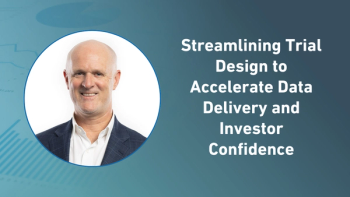
- Applied Clinical Trials-06-01-2021
- Volume 30
- Issue 6
5 Ways DCTs Can Positively Impact Trial Diversity
COVID-19 forces life sciences industry to make long overdue changes.
As a response to the worldwide shutdown of non-essential businesses and to maintain clinical trial continuity, the industry turned to decentralized clinical trials (DCTs). Digital clinical trial tools–including eConsents, eSource, electronic patient reported outcomes (ePROs), electronic clinical outcomes assessments (eCOAs), telehealth visits, medication adherence apps, and eDiaries–have made it easier for patients to participate, ultimately positively impacting real-world clinical trial outcomes. It’s no surprise that these tools to decentralize research are being used increasingly. Industry Standard Research’s 2020 survey indicated over 40% of sponsors are currently using hybrid trials and another 32% said they had plans to start using hybrid trials in the next two years.1
As life sciences companies began transitioning from brick-and-mortar clinical sites to a decentralized “virtual” research model where study procedures can take place remotely, clinical research ostensibly became more accessible to a broader swath of patients. This new approach dramatically reduced the most common burdens inherent to traditional trial participation. While there are many upsides, one of the most dramatic benefits offered by decentralized trials is the potential to engage historically underrepresented communities.
This sharp increase in decentralized research came at a time in the United States when racial inequity and social injustice came into sharp focus. Industrywide, the call for greater diversity has never been louder. Historically, only 17% of study participants at any given time and across all therapeutic specialties are people of color.2 By contrast, the Centers for Disease Control and Prevention (CDC) shows the disproportionate disease burden on the same populations in the same therapeutic areas.
More specifically, Moderna and Pfizer’s COVID-19 vaccine trials faced scrutiny that raised concerns were about inadequate recruitment of minority populations and those most impacted by COVID-19 exposure, infection, morbidity, and mortality. The problem became so concerning that FDA expanded its guidelines for enhancing the diversity of clinical trial populations.3
Despite recent and profound medical and technological advances, there is limited evidence of these changes moving the needle toward more equitable clinical trial recruitment or improved health outcomes for racial and ethnic minorities. While decentralized clinical trials (DCTs) have great potential to improve these inequities, relying on them alone without accepting their limitations puts too much pressure on novel technologies when awareness of clinical trials and broad acceptance has not been embraced by communities of color.
Decentralizing to ease patient burden
One key reason why patient recruitment is so challenging is that traditional clinical trials often require patients to take time off from work, have ready transportation, and navigate a host of other inconveniences. Not surprisingly, these factors make many study opportunities inaccessible to the individuals and communities that need them the most. DCTs hold the promise of removing these burdens. In the last year, DCTs have improved recruitment rates by approximately 80%.4
Easier participation equates to improved patient compliance, as well. The “in-the-moment” patient accounts afforded by a decentralized approach offer the advantage of more accurate recollections of their experiences than data captured in-person, but weeks later. Patients offered the opportunity to provide study data in the context of their home environments and day-to-day lives also brings the benefit of allowing ongoing improvement of digital health solutions and clinical care. On their face, DCTs offer patients an easier way to participate in trials by providing technology as the intermediary, potentially making participation not only more acceptable but also attractive. Bringing trials to a patient’s home enables the ultimate patient-centric trial experience, replete with easy access to ongoing, high-quality resources and a care team not otherwise easily accessible.
DCTs also have the power to speed patient recruitment, while reducing drop-out rates, possibly saving millions of dollars per day. As of 2016, 85% of trials failed to finish on time, greatly increasing the financial burden on sponsors. Additionally, the ability to collect high-quality clinical and real-world data provide stronger evidence packages and digital endpoints to generate differentiated label claims.5
In addition to DCTs’ potential for increased patient enrollment and retention efficiency, they can also enable trial teams to recruit a more inclusive, representative participant population. Yet, DCTs–still evolving–are just one path to diversity. So, what else can be done to bridge the gaps in diversity, equity, and inclusion in clinical trials? As critical, how can combine the drive for decentralized clinical trials and improved equality to ensure truly effective and meaningful change across the industry?
Here are five ways to start moving that needle.
1. Acknowledge inherent privilege and bias up front
Recognize that privilege permeates the clinical trial landscape so most who work within it see with only a limited lens. Trial teams can no longer dismiss obstacles or diminish their impact upstream. Just because a team member does not clearly see a problem does not mean it does not exist. Want to know what works? Ask someone. And then listen. Go back to the drawing board incorporating invaluable intel from the patient populations you seek to engage, then bring them back something that demonstrates they were heard. Repeat until you get it right. Remember this simple equation: Bias in, bias out.
2. Accountability starts with leadership
Inclusion starts at the top.
According to data compiled by Shonda Anderson-Williams, healthcare and life sciences digital transformation leader at Microsoft, diverse companies outperform the competition by 35%. Further, millennials are looking for a more diverse and inclusive workplace with 62% saying they want a career with social impact and purpose, and as many as 72% saying they would leave an organization for a more inclusive one.6 But tangible leadership is demanded for one of the most important issues of our times. This kind of leadership can face injury and assault by people who use defensive diatribes. Leadership, however, means pushing back and then measuring the impact of that response. Leadership always sets something measurable into motion. Take a stand. Otherwise, take a seat.
Global Head of D&I at Astellas Pharma, Eloiza Domingo, says pharmaceutical companies should include diversity leaders in their product lifecycle teams and think about how they look at issues such as supplier diversity, community volunteerism, and corporate social responsibility efforts. It is also important to educate managers around hiring, promoting, and engaging diverse talent. Organizations need to build a clear case for diversity, inclusion, and cultural competence into their mission and values and articulate that from the bottom up and the top down.
3. Develop community communications competence
Organizations must start any new trial effort by building community relationships. All too often, enrollment fails due to a lack of any established relationships. Overcome these enrollment barriers by becoming worthy of trust.
Fostering these relationships begins with dialogue to understand the concerns of marginalized communities. Support local educational initiatives that center around creating better health outcomes. Embrace a continuous feedback loop and take criticism with grace. Operationalize ways to consistently collect input from patients the way Medable is doing today, with its Patient Advisory Council.
Once there is a framework established, then follow through with those recommendations. The key to change is meeting people where they are. Lack of trust is well-rooted in history, perception, and fear of ongoing victimization. Thus, any organization looking to make inroads with new populations must first acknowledge the historical facts that got us where we are, and then work to move past it.
4. Center the human Factor in decentralized trials
Relying on digital technology to the exclusion of human interaction misses out on the texture of relationships and the very foundation of trust-building—a critical component of effectively engaging communities of color who may often carry justifiable baggage. Relationships matter, particularly when it comes to patient recruitment, and the more the industry humanizes the process, the more humans will feel comfortable taking part in it.
In addition, verify the validity of key performance indicators by making space for real feedback by real people and develop a workflow with an iterative, inclusive process. Use those algorithms to build in checks and balances and that make performance clear based on standards set by the full patient market.
5. Address real accessibility challenges
DCTs bring the trial to the patient, removing the burdens of travel and distance, as well as the need to take time off from work. This, in turn, makes trials more accessible across all demographics. At the same time, DCTs require smart devices or computers and a reliable internet connection. The same communities that lack access to traditional trials may also live in areas where there’s immature digital infrastructure. Study sponsors looking to diversify recruitment and democratize access can get an advantage by providing dedicated, reliable, high-speed internet when such situations arise.
While merely setting up a site in a location near a population of color does not translate into study enrollees, DCTs can go a long way to begin to bridge the racial rift. Companies that have leveraged a decentralized model have achieved unprecedented results, including three-times faster patient enrollment and over 90% patient retention rates.7 The decentralized model has opened doors to more patients and reduced racial disparity in healthcare to improve overall outcomes. And, with increased trial access across all demographics, study data will grow more all-encompassing for greater insight into developing new treatments that help more people.
Given the road we’ve travelled to get here, infusing decentralized trials with cultural sensitivity and patient-centricity is more important than ever if to diversify study enrollment.
References
- Clinical Leader, “Warming Up To Hybrid Trials,” by Rebecca McAvoy (February 3, 2021). See full resource here:
https://bit.ly/34dA0Ja . - Clinical Researcher, Association of Clinical Research Professionals, Representation in Clinical Trials: A Review of Reaching Underrepresented Populations in Research,” by Isabelle Yates, Jennifer Byrne, Susan Donahue, Linda McCarty, and Allison Mathews (August 10, 2020). See the full resource here:
https://bit.ly/2QQ682q . - FDA.gov, “Guidance Document: Enhancing the Diversity of Clinical Trial Populations,” (November 13, 2020). See the full resource here:
https://bit.ly/3tiwCrD . - antidote, “What clinical trial statistics tell us about the state of research today,” by Eian Kantor (September 10, 2020) See full resource here:
https://bit.ly/34eN54J . - PRA Health Sciences, “Bridging the Diversity Gap With Decentralized Trials,” by Kent Thoelke, Tami Klerr, Scott Schliebner. See full resource here:
https://bit.ly/3yKzSPo . - PharmaVOICE WOW Podcast, “Shonda Anderson-Williams,” by Taren Grom (September 23, 2020) See full resource here:
https://bit.ly/3uldRmx . - Outsourcing-Pharma, “Medable advisory council works to amplify patient voice, inclusivity,” by Jenni Spinner (March 24, 2021). See full resource here:
https://bit.ly/3wur6Tv .
About the authors
Allison Kalloo, MPH, is founder and CEO of Clinical Ambassador Inc., founder of iParticipate Inc., Community Engagement Director and Innovation Strategist with EthosExcel. She is also a member of the Medable Patient Advisory Council (PAC). Kalloo can be reached at
Joni Venticinque is a patient advocate with extensive first-hand experience as an advocate in oncology as well as in the industry. She has helped patients navigate their medical journey at the Stanford Cancer Center and at Bay Area Cancer Connections. She currently volunteers with The Second Opinion to help patients connect to services and information about their cancer and is a founding member of the Cancer Patient Advocacy Alliance, serving as an advocate member for grant proposals submitted to the California Breast Cancer Research Program, Department of Defense Breast Cancer Research Program, NCI and the Patient Centered Outcomes Research Institute. Venticinque is also a founding member of the Medable Patient Advisory Council (PAC).
Articles in this issue
over 4 years ago
Rare Disease Patients Overlooked During COVIDover 4 years ago
The Many Paths of Diversity in Clinical Trialsover 4 years ago
Contemplating the Full Measure of Pandemic Responseover 4 years ago
Shifting from Paper to Digital Patient Consentover 4 years ago
The Tangled Web of Large Outsourced Providersover 4 years ago
Clinical Trials Diversity and Inclusionover 4 years ago
Applied Clinical Trials June 2021 Issue (PDF)over 4 years ago
Is COVID A Game-Changer for Wider Drug Development Policy?over 4 years ago
FDA Promotes Master Protocols to Modernize Clinical TrialsNewsletter
Stay current in clinical research with Applied Clinical Trials, providing expert insights, regulatory updates, and practical strategies for successful clinical trial design and execution.






.png)



.png)



.png)
.png)
